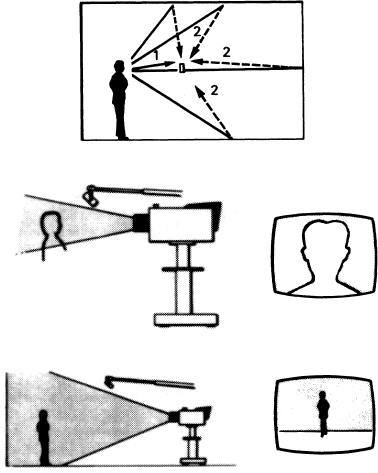Sound Perspective
The term sound perspective means the apparent distance of a sound, as judged by the ears. A number of factors are involved but the most important is the ratio of the direct sound to the indirect sound. The direct sound is that which goes directly from source to microphone (or ear). The indirect sound is that which undergoes reflections first; it is in fact the reverberant sound.
In everyday life we are often unaware of sound perspectives, largely because, with two ears, it is possible for the brain to discriminate against what it regards as unimportant noises such as reverberation. However, a microphone system cannot do this, and consequently distances of a source of sound from the microphone often seem exaggerated when reproduced.
Matching sound and picture
Sometimes, but not always, it is important that visual perspectives and sound perspectives are in agreement. For example, in a dramatic context, we might have a dialogue between an actor near to camera with one seen to be some distance away. It will seem unnatural if the distant actor sounds as close as the near one. (It will be far worse if the perspectives are the other way round!) Thus we may need to have a close microphone on the near actor and a somewhat less close one on the distant actor. A degree of experimenting will soon show what is right for any situation.
There are many occasions when this matching of visual and sound perspectives is not needed. For example, in a commercial or a documentary, intelligibility of the presenters, however far away they look, is usually going to be much more important than the perspective of their voice.
Sound perspectives can be significant in music. The instruments seen at the back of a band or orchestra should normally sound less close than the front-line ones—and applause from an audience certainly should sound more distant than the band.

The microphone picks up a mixture of direct sound from the source (1 ), and reflected sounds from its surroundings (2)—walls, floor, ceiling. The closer the microphone to the source, the greater the proportion of direct sound pick-up.
Close ups
A close microphone position is required to give a sound perspective suitable for close shots.
Distant shots
For more distant shots, the microphone is positioned correspondingly farther away to provide an appropriate mixture of direct and reflected sounds.
